engine Citroen C5 2017 (RD/TD) / 2.G Owners Manual
[x] Cancel search | Manufacturer: CITROEN, Model Year: 2017, Model line: C5, Model: Citroen C5 2017 (RD/TD) / 2.GPages: 348, PDF Size: 10.72 MB
Page 237 of 348
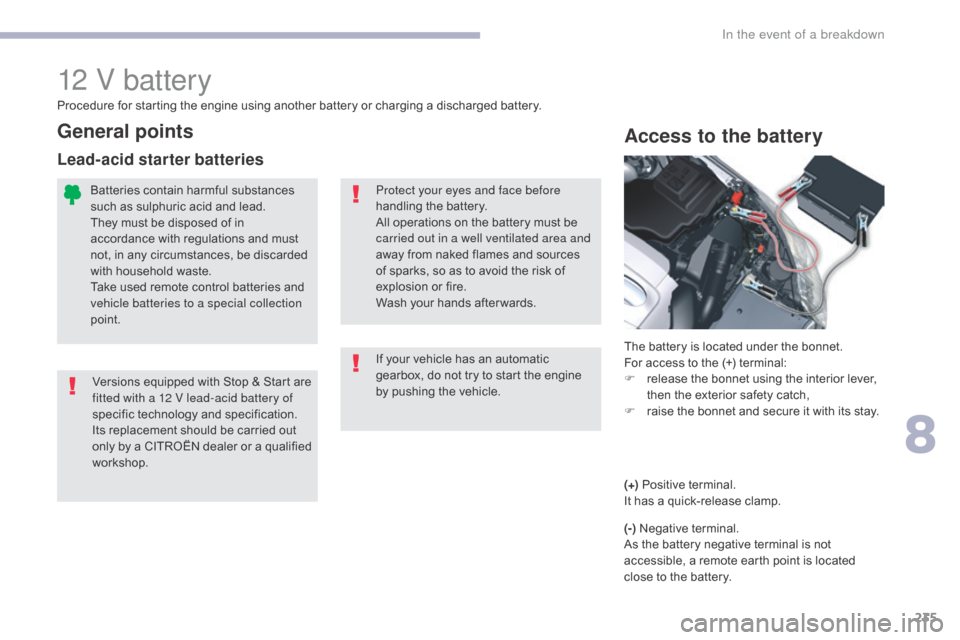
235
C5_en_Chap08_en-cas-de-panne_ed01-2016
12 V battery
Access to the battery
The battery is located under the bonnet.
For access to the (+) terminal:
F
r
elease the bonnet using the interior lever,
then the exterior safety catch,
F
r
aise the bonnet and secure it with its stay.
Protect your eyes and face before
handling the battery.
All operations on the battery must be
carried out in a well ventilated area and
away from naked flames and sources
of sparks, so as to avoid the risk of
explosion or fire.
Wash your hands after wards.
If your vehicle has an automatic
gearbox, do not try to start the engine
by pushing the vehicle.
Versions equipped with Stop & Start are
fitted with a 12 V lead-acid battery of
specific technology and specification.
Its replacement should be carried out
only by a CITROËN dealer or a qualified
workshop.
Procedure for starting the engine using another battery or charging a discharged battery.
General points
Batteries contain harmful substances
such as sulphuric acid and lead.
They must be disposed of in
accordance with regulations and must
not, in any circumstances, be discarded
with household waste.
Take used remote control batteries and
vehicle batteries to a special collection
point.
Lead-acid starter batteries
(+)
Positive terminal.
It has a quick-release clamp.
(-) Negative terminal.
As the battery negative terminal is not
accessible, a remote earth point is located
close to the battery.
8
In the event of a breakdown
Page 238 of 348
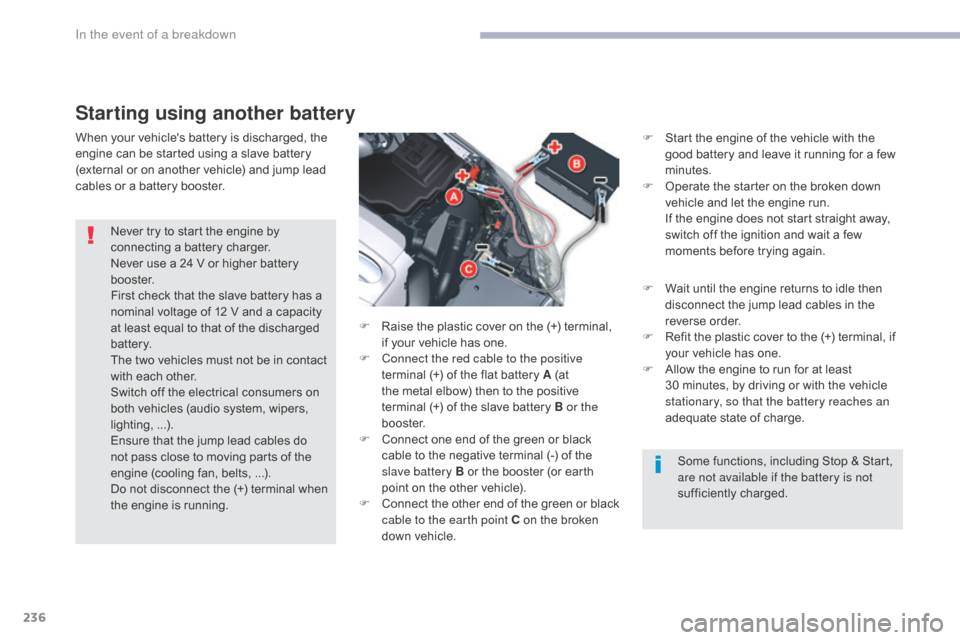
236
C5_en_Chap08_en-cas-de-panne_ed01-2016
Starting using another battery
When your vehicle's battery is discharged, the
engine can be started using a slave battery
(external or on another vehicle) and jump lead
cables or a battery booster.F
S tart the engine of the vehicle with the
good battery and leave it running for a few
minutes.
F
O
perate the starter on the broken down
vehicle and let the engine run.
I
f the engine does not start straight away,
switch off the ignition and wait a few
moments before trying again.
Never try to start the engine by
connecting a battery charger.
Never use a 24 V or higher battery
b o o s t e r.
First check that the slave battery has a
nominal voltage of 12 V and a capacity
at least equal to that of the discharged
battery.
The two vehicles must not be in contact
with each other.
Switch off the electrical consumers on
both vehicles (audio system, wipers,
lighting, ...).
Ensure that the jump lead cables do
not pass close to moving parts of the
engine (cooling fan, belts, ...).
Do not disconnect the (+) terminal when
the engine is running. Some functions, including Stop & Start,
are not available if the battery is not
sufficiently charged.
F
R
aise the plastic cover on the (+) terminal,
if your vehicle has one.
F
C
onnect the red cable to the positive
terminal (+) of the flat battery A (at
the metal elbow) then to the positive
terminal
(+) of the slave battery B or the
b o o s t e r.
F
C
onnect one end of the green or black
cable to the negative terminal (-) of the
slave battery B or the booster (or earth
point on the other vehicle).
F
C
onnect the other end of the green or black
cable to the earth point C on the broken
down vehicle. F
W
ait until the engine returns to idle then
disconnect the jump lead cables in the
reverse order.
F
R
efit the plastic cover to the (+) terminal, if
your vehicle has one.
F
A
llow the engine to run for at least
30
minutes, by driving or with the vehicle
stationary, so that the battery reaches an
adequate state of charge.
In the event of a breakdown
Page 240 of 348
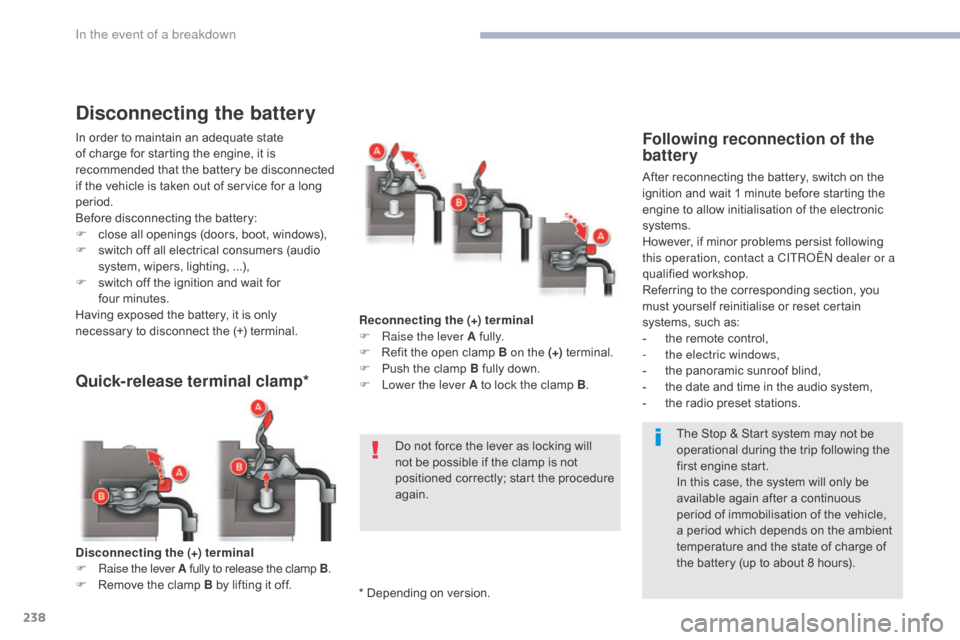
238
C5_en_Chap08_en-cas-de-panne_ed01-2016
Disconnecting the (+) terminal
F Ra ise the lever A fully to release the clamp B .
F
R
emove the clamp B by lifting it off.
Quick-release terminal clamp*
Reconnecting the (+) terminal
F Ra ise the lever A fully.
F
R
efit the open clamp B on the (+) terminal.
F
P
ush the clamp B fully down.
F
L
ower the lever A to lock the clamp B .
Do not force the lever as locking will
not be possible if the clamp is not
positioned correctly; start the procedure
again.
Disconnecting the battery
In order to maintain an adequate state
of charge for starting the engine, it is
recommended that the battery be disconnected
if the vehicle is taken out of service for a long
period.
Before disconnecting the battery:
F
c
lose all openings (doors, boot, windows),
F
s
witch off all electrical consumers (audio
system, wipers, lighting, ...),
F
s
witch off the ignition and wait for
four
m
inutes.
Having exposed the battery, it is only
necessary to disconnect the (+) terminal.Following reconnection of the
battery
After reconnecting the battery, switch on the
ignition and wait 1 minute before starting the
engine to allow initialisation of the electronic
systems.
However, if minor problems persist following
this operation, contact a CITROËN dealer or a
qualified workshop.
Referring to the corresponding section, you
must yourself reinitialise or reset certain
systems, such as:
-
t
he remote control,
-
t
he electric windows,
-
t
he panoramic sunroof blind,
-
t
he date and time in the audio system,
-
t
he radio preset stations.The Stop & Start system may not be
operational during the trip following the
first engine start.
In this case, the system will only be
available again after a continuous
period of immobilisation of the vehicle,
a period which depends on the ambient
temperature and the state of charge of
the battery (up to about 8 hours).
* Depending on version.
In the event of a breakdown
Page 241 of 348
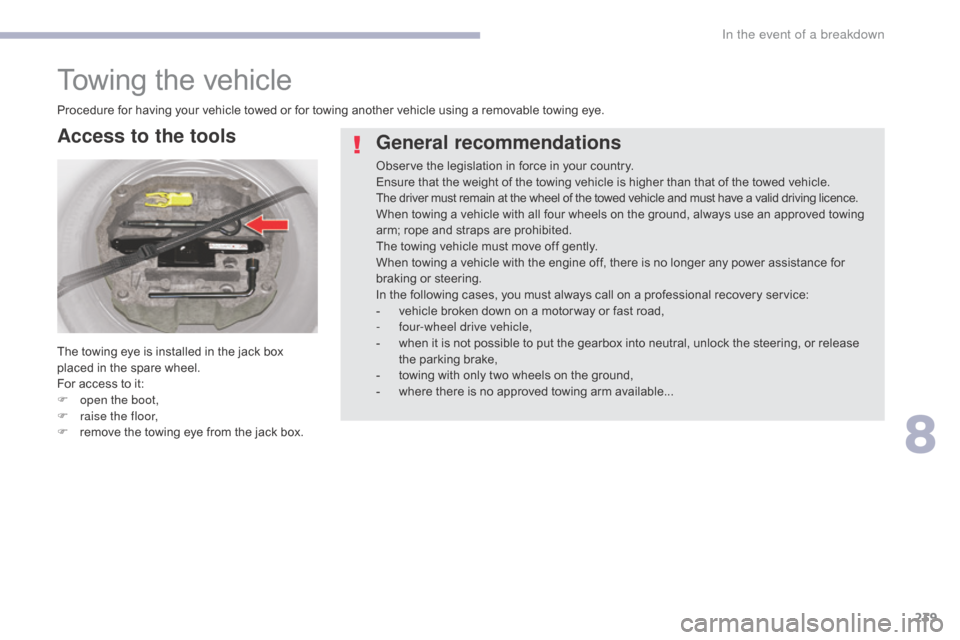
239
C5_en_Chap08_en-cas-de-panne_ed01-2016
Towing the vehicle
Procedure for having your vehicle towed or for towing another vehicle using a removable towing eye.
The towing eye is installed in the jack box
placed in the spare wheel.
For access to it:
F
o
pen the boot,
F
r
aise the floor,
F
r
emove the towing eye from the jack box.
Access to the tools General recommendations
Observe the legislation in force in your country.
Ensure that the weight of the towing vehicle is higher than that of the towed vehicle.
The driver must remain at the wheel of the towed vehicle and must have a valid driving licence.
When towing a vehicle with all four wheels on the ground, always use an approved towing
arm; rope and straps are prohibited.
The towing vehicle must move off gently.
When towing a vehicle with the engine off, there is no longer any power assistance for
braking or steering.
In the following cases, you must always call on a professional recovery service:
-
v
ehicle broken down on a motor way or fast road,
-
f
our-wheel drive vehicle,
-
w
hen it is not possible to put the gearbox into neutral, unlock the steering, or release
the parking brake,
-
t
owing with only two wheels on the ground,
-
w
here there is no approved towing arm available...
8
In the event of a breakdown
Page 242 of 348
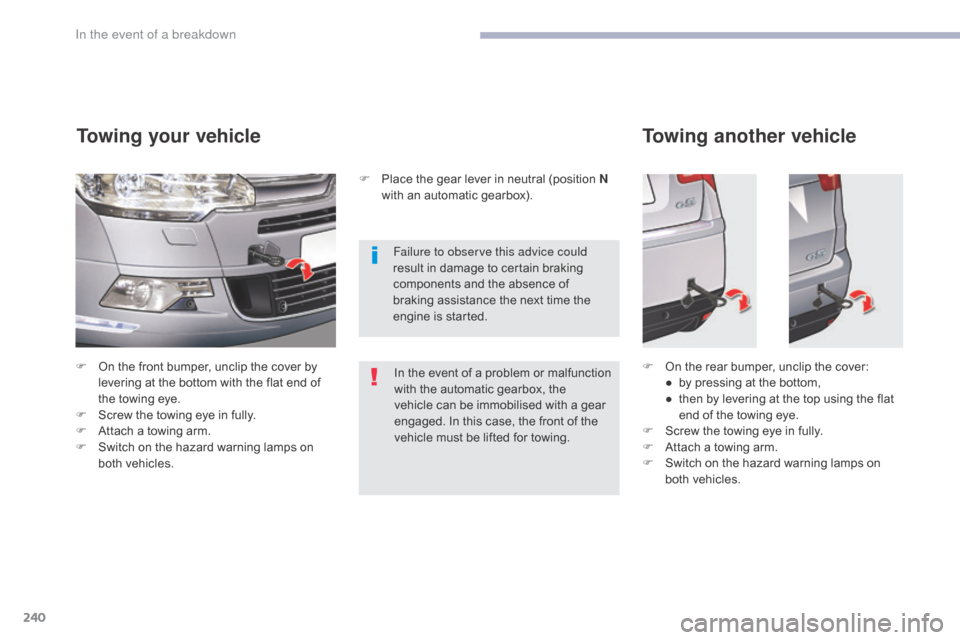
240
C5_en_Chap08_en-cas-de-panne_ed01-2016
F On the front bumper, unclip the cover by levering at the bottom with the flat end of
the towing eye.
F
S
crew the towing eye in fully.
F
A
ttach a towing arm.
F
S
witch on the hazard warning lamps on
both vehicles.
Towing your vehicle
Failure to observe this advice could
result in damage to certain braking
components and the absence of
braking assistance the next time the
engine is started.
In the event of a problem or malfunction
with the automatic gearbox, the
vehicle can be immobilised with a gear
engaged. In this case, the front of the
vehicle must be lifted for towing. F
O
n the rear bumper, unclip the cover:
●
b
y pressing at the bottom,
●
t
hen by levering at the top using the flat
end of the towing eye.
F
S
crew the towing eye in fully.
F
A
ttach a towing arm.
F
S
witch on the hazard warning lamps on
both vehicles.
Towing another vehicle
F Place the gear lever in neutral (position N with an automatic gearbox).
In the event of a breakdown
Page 243 of 348
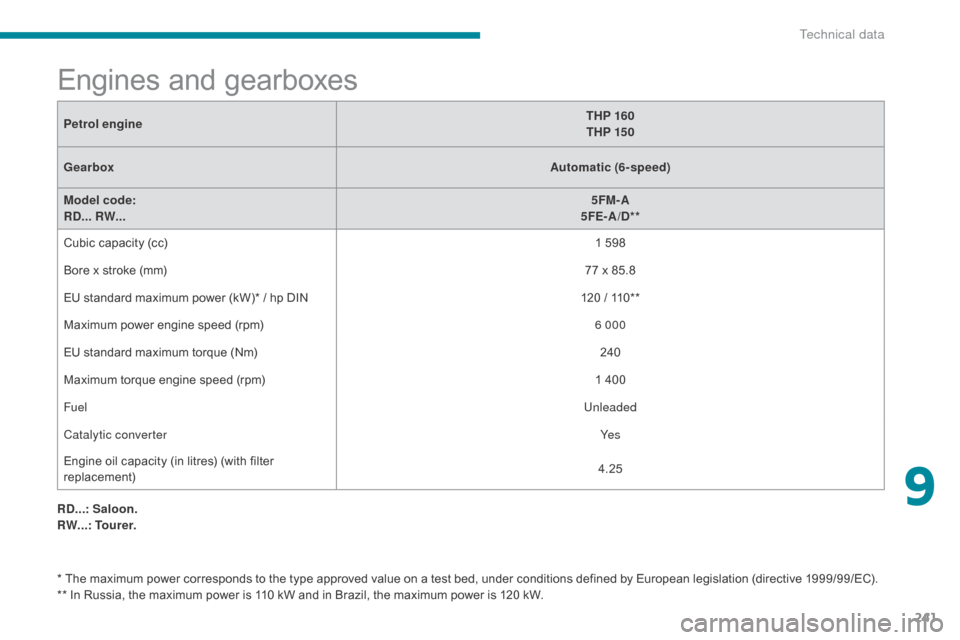
241
C5_en_Chap09_caracteristiques-techniques_ed01-2016
Engines and gearboxes
Petrol engineTHP 160
THP 15 0
Gearbox Automatic (6-speed)
Model code:
RD... RW... 5FM-A
5FE-A /D**
Cubic capacity (cc) 1 598
Bore x stroke (mm) 77 x 85.8
EU standard maximum power (kW)* / hp DIN 120 / 110**
Maximum power engine speed (rpm) 6 000
EU standard maximum torque (Nm) 240
Maximum torque engine speed (rpm) 1 400
Fuel Unleaded
Catalytic converter Ye s
Engine oil capacity (in litres) (with filter
replacement) 4.25
* The maximum power corresponds to the type approved value on a test bed, under conditions defined by European legislation (directive 1999/99/EC).
** In Russia, the maximum power is 110 kW and in Brazil, the maximum power is 120 kW. RD... : Saloon.
RW...: Tourer.
9
Technical data
Page 244 of 348
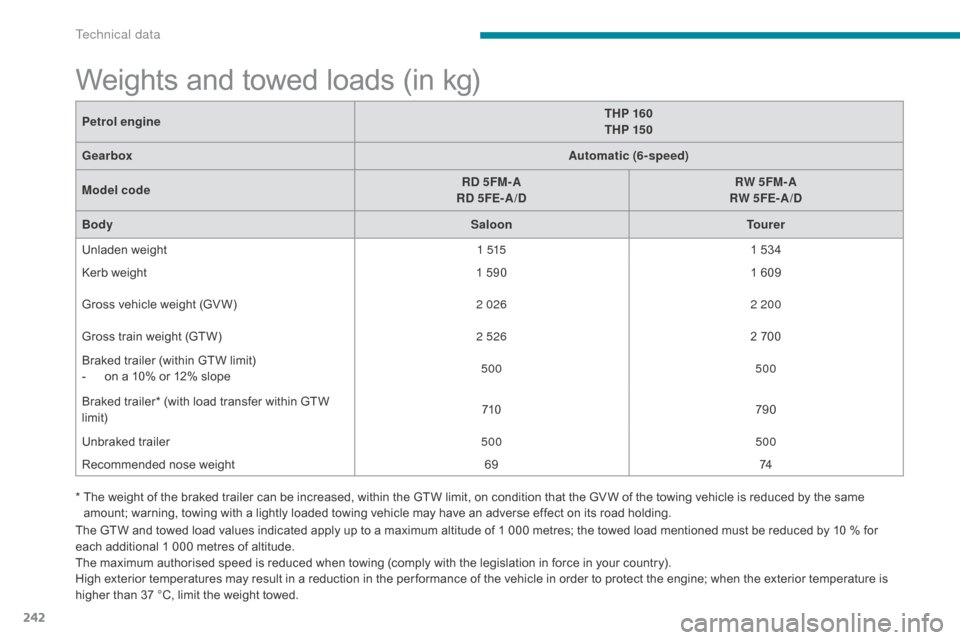
242
C5_en_Chap09_caracteristiques-techniques_ed01-2016
Weights and towed loads (in kg)
Petrol engineTHP 160
THP 15 0
Gearbox Automatic (6-speed)
Model code RD 5FM-A
RD 5FE-A /D RW 5FM-A
RW 5FE-A/D
Body SaloonTourer
Unladen weight 1 5151 534
Kerb weight 1 5901 609
Gross vehicle weight (GV W) 2 0262 200
Gross train weight (GTW) 2 5262 700
Braked trailer (within GTW limit)
-
o
n a 10% or 12% slope 500
500
Braked trailer* (with load transfer within GTW
limit) 710
790
Unbraked trailer 500500
Recommended nose weight 6974
The GTW and towed load values indicated apply up to a maximum altitude of 1 000 metres; the towed load mentioned must be reduced by 10 % for
each additional 1 000 metres of altitude.
The maximum authorised speed is reduced when towing (comply with the legislation in force in your country).
High exterior temperatures may result in a reduction in the per formance of the vehicle in order to protect the engine; when the exterior temperature is
higher than 37 °C, limit the weight towed. *
T
he weight of the braked trailer can be increased, within the GTW limit, on condition that the GV W of the towing vehicle is reduced by the same
amount; warning, towing with a lightly loaded towing vehicle may have an adverse effect on its road holding.
Technical data
Page 245 of 348
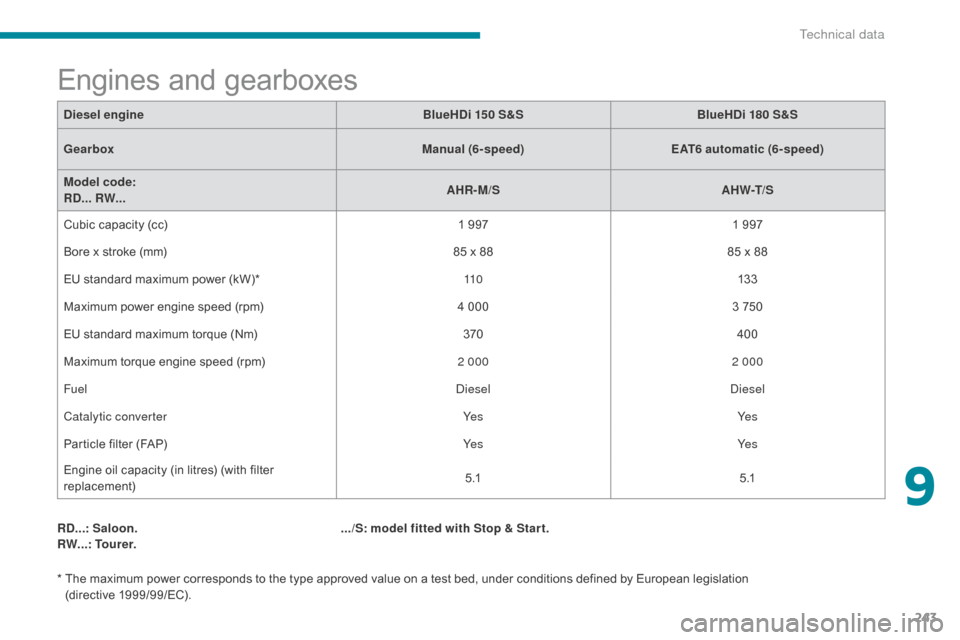
243
C5_en_Chap09_caracteristiques-techniques_ed01-2016
RD...: Saloon.
RW...: Tourer.
*
T
he maximum power corresponds to the type approved value on a test bed, under conditions defined by European legislation
(directive 1999/99/EC).
Engines and gearboxes
Diesel engine BlueHDi 150 S&SBlueHDi 180 S&S
Gearbox Manual (6-speed)EAT6 automatic (6-speed)
Model code:
RD... RW... AHR- M/S
AHW-T/S
Cubic capacity (cc) 1 9971 997
Bore x stroke (mm) 85 x 8885 x 88
EU standard maximum power (kW)* 11 013 3
Maximum power engine speed (rpm) 4 0003 750
EU standard maximum torque (Nm) 370400
Maximum torque engine speed (rpm) 2 0002 000
Fuel DieselDiesel
Catalytic converter Ye sYe s
Particle filter (FAP) Ye sYe s
Engine oil capacity (in litres) (with filter
replacement) 5 .1
5 .1
.../S : model fitted with Stop & Star t.
9
Technical data
Page 246 of 348
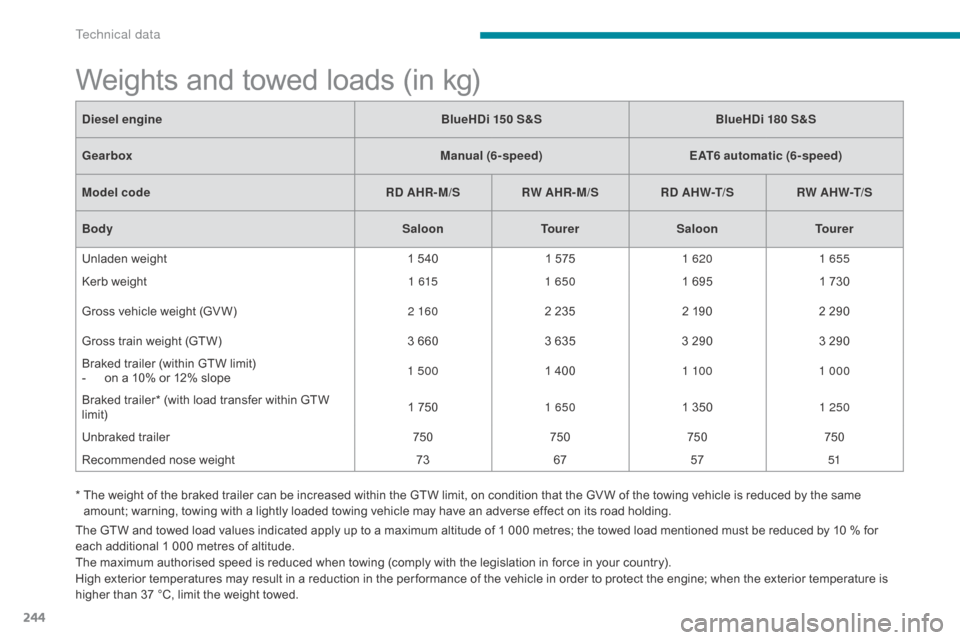
244
C5_en_Chap09_caracteristiques-techniques_ed01-2016
Diesel engineBlueHDi 15 0 S&S BlueHDi 180 S&S
Gearbox Manual (6-speed)EAT6 automatic (6-speed)
Model code RD AHR- M/SRW AHR- M/S RD AHW-T/SRW AHW-T/S
Body SaloonTourerSaloon Tourer
Unladen weight 1 5401 5751 620 1 655
Kerb weight 1 6151 650 1 695 1 730
Gross vehicle weight (GV W) 2 1602 235 2 1902 290
Gross train weight (GTW) 3 6603 6353 290 3 290
Braked trailer (within GTW limit)
-
o
n a 10% or 12% slope 1 500
1 400 1 10 01 000
Braked trailer* (with load transfer within GTW
limit) 1 750
1 650 1 350 1 250
Unbraked trailer 750750750750
Recommended nose weight 736757 51
The GTW and towed load values indicated apply up to a maximum altitude of 1 000 metres; the towed load mentioned must be reduced by 10 % for
each additional 1 000 metres of altitude.
The maximum authorised speed is reduced when towing (comply with the legislation in force in your country).
High exterior temperatures may result in a reduction in the per formance of the vehicle in order to protect the engine; when the exterior temperature is
higher than 37 °C, limit the weight towed. *
T
he weight of the braked trailer can be increased within the GTW limit, on condition that the GV W of the towing vehicle is reduced by the same
amount; warning, towing with a lightly loaded towing vehicle may have an adverse effect on its road holding.
Weights and towed loads (in kg)
Technical data
Page 313 of 348
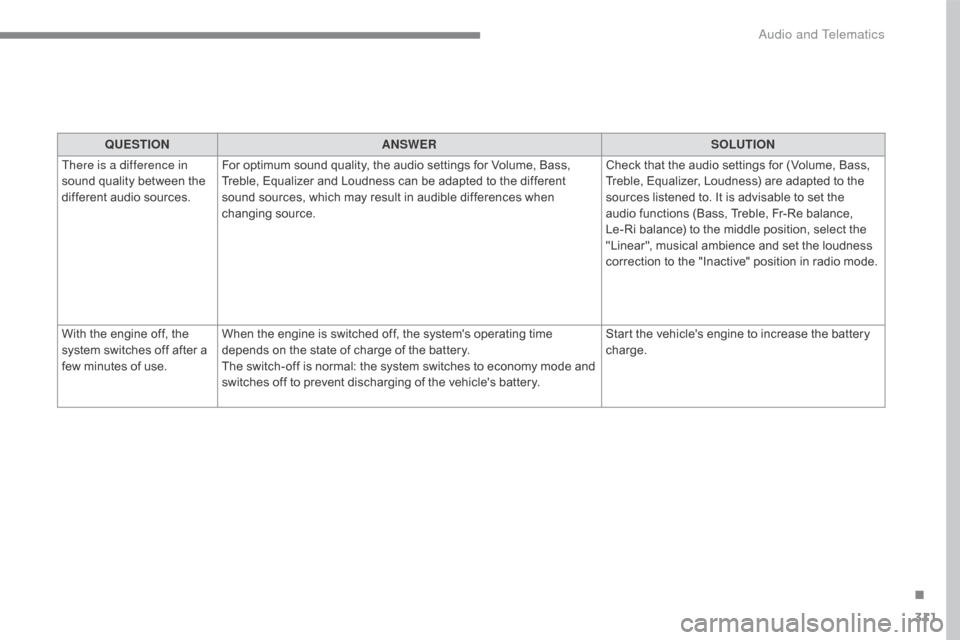
311
C5_en_Chap10b_SMEGplus_ed01-2016
QUESTIONANSWER SOLUTION
There is a difference in
sound quality between the
different audio sources. For optimum sound quality, the audio settings for Volume, Bass,
Treble, Equalizer and Loudness can be adapted to the different
sound sources, which may result in audible differences when
changing source. Check that the audio settings for (Volume, Bass,
Treble, Equalizer, Loudness) are adapted to the
sources listened to. It is advisable to set the
audio functions (Bass, Treble, Fr-Re balance,
Le-Ri balance) to the middle position, select the
"Linear", musical ambience and set the loudness
correction to the "Inactive" position in radio mode.
With the engine off, the
system switches off after a
few minutes of use. When the engine is switched off, the system's operating time
depends on the state of charge of the battery.
The switch-off is normal: the system switches to economy mode and
switches off to prevent discharging of the vehicle's battery. Start the vehicle's engine to increase the battery
charge.
.
Audio and Telematics